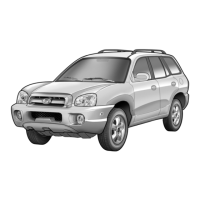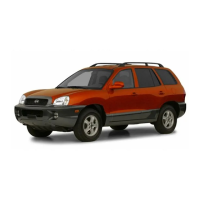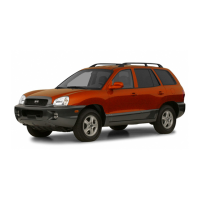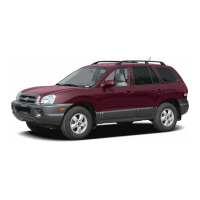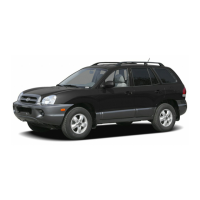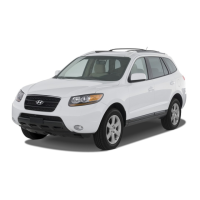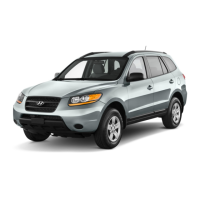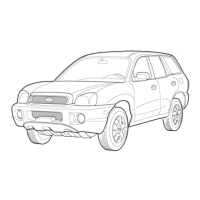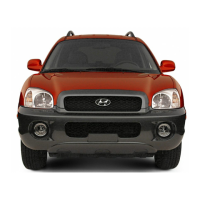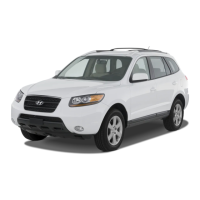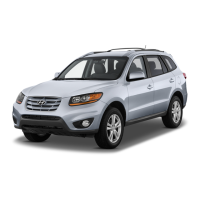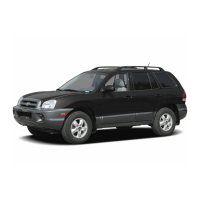
Do you have a question about the Hyundai 2006 Santa Fe and is the answer not in the manual?
| Brand | Hyundai |
|---|---|
| Model | 2006 Santa Fe |
| Category | Automobile |
| Language | English |
Details on recommended unleaded gasoline, gasohol, MTBE, and methanol for your Hyundai.
Instructions on operating vehicle door locks, including warnings about accidental opening.
Information on adjusting front seats, seatback angle, and lumbar support for comfort and safety.
Precautions and instructions for using seat belts, including child restraint system information.
Guidelines for using child restraint systems, including proper installation and safety.
Explanation of the SRS system, including airbag components, operation, and safety precautions.
Overview of the instrument cluster and explanations of various indicator lights and symbols.
Guide to operating the stereo radio, compact disc player, and cassette tape player.
Instructions for operating the vehicle's climate control system, including ventilation and air conditioning.
Safety warnings regarding engine exhaust fumes, including risks of carbon monoxide poisoning.
Information on the higher rollover risk of SUVs and precautions to avoid it.
Checklist of essential pre-driving inspections for vehicle safety and readiness.
Guide to operating the 4-speed A/T and 5-speed A/T automatic transaxle, including Sports Mode.
Recommendations for safe and efficient driving, including smooth acceleration and braking.
Explanation of how ABS works to prevent wheel lock-up during braking.
Guidelines and precautions for safely towing trailers or other vehicles with your Hyundai.
Information on determining correct load limits, seating capacity, and towing capacity.
Troubleshooting steps for when the engine fails to start or starts slowly.
Procedure for safely jump-starting a vehicle with a discharged battery using jumper cables.
Steps to take if the engine overheats, including safety precautions and coolant checks.
Step-by-step guide on how to safely change a flat tire, including wheel and jack placement.
Instructions and cautions for towing your vehicle, including proper procedures for 2WD and 4WD models.
Information on understanding and preventing corrosion on your Hyundai vehicle.
Guidelines for washing, drying, polishing, and waxing your Hyundai to maintain its finish.
Instructions for cleaning interior surfaces like vinyl upholstery, leather upholstery, and bumpers.
Overview of service requirements, maintenance intervals, and general checks for your Hyundai.
Detailed schedule of maintenance services for emission control items and general vehicle components.
Specific maintenance items and intervals required for vehicles driven under severe conditions.
Detailed explanation of various scheduled maintenance items, such as engine oil, fuel filter, and drive belts.
Identification of key components in the engine compartment for routine checks and maintenance.
Procedure for checking the engine oil level and recommended oil specifications.
Step-by-step instructions for draining and refilling engine oil and replacing the oil filter.
Guidance on checking brake fluid level and brake pedal clearance for safety.
Instructions for replacing various exterior and interior light bulbs, including safety precautions.
Diagram and description of the fuse panel locations and the components protected by each fuse.
Explanation of the positive crankcase ventilation system for preventing air pollution.
Description of the system designed to prevent fuel vapors from escaping into the atmosphere.
Overview of the system that controls exhaust emissions while maintaining vehicle performance.
Information about the catalytic converter, its function, and precautions to prevent overheating.
Details on Hyundai's tire choices for optimal performance and where to find warranty service.
Guidelines for maintaining proper tire inflation pressures for ride comfort, wear, and stability.
Explanation of the standardized information found on tire sidewalls, including size and identification.
Definitions of common tire terms such as air pressure, aspect ratio, bead, and DOT markings.
Information on how to report vehicle safety defects to NHTSA and Hyundai Motor America.
Details on the binding arbitration agreement for warranty claims and dispute resolution.
Key dimensions of the vehicle, including overall length, width, height, and wheelbase.
Specifications for standard and spare tires, including size and recommended tire pressure.
Detailed specifications for the 2.7L V6 and 3.5L V6 engines, including bore, stroke, and displacement.
Recommended fluids and standards for engine oil, transaxle, coolant, and other vehicle systems.
